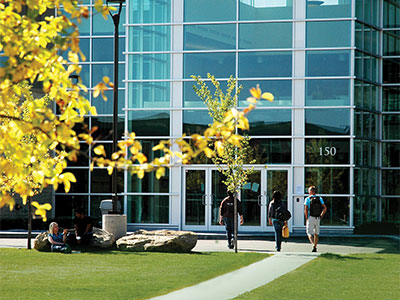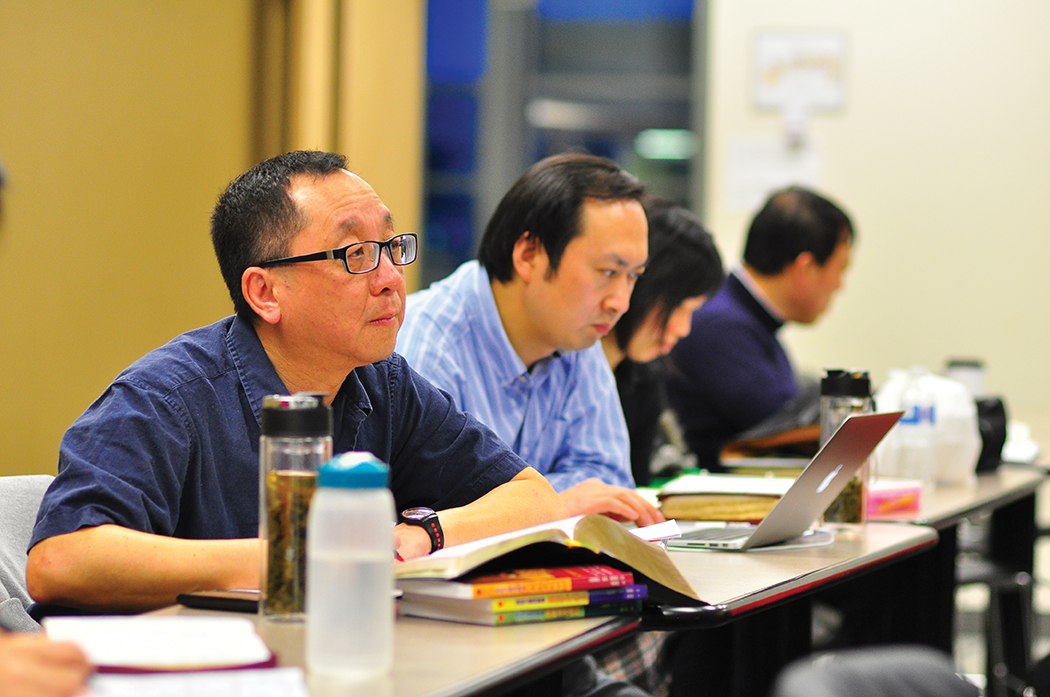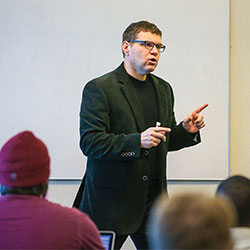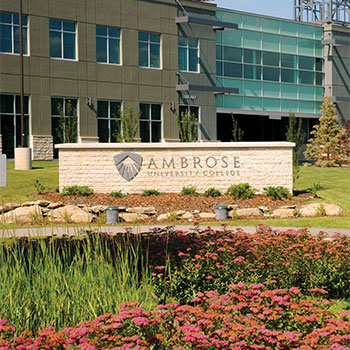 |
Ambrose University is in southwest Calgary, a city of one million.
Credit: Ambrose University |
It is not unusual for Kenneth A. Stankievech, chair of the board of Ambrose University, to feel something like euphoria when he walks out of a board meeting at the Ambrose campus in southwest Calgary.
With about a million residents, Calgary is the largest city in Alberta, known for its oil and gas industry, its proximity to the majestic Rockies, and its annual rodeo, the Calgary Stampede. Canada’s third largest municipality is still comfortable in a cowboy hat.
And in Christian circles, Calgary is also increasingly known as the home of Ambrose, which calls itself “a community of transformative Christian higher education — with a vision for the welfare of our city and our world.” More than 920 students are currently enrolled at the school, which is a product of a 2007 merger between Alliance University College (AUC) and Nazarene University College (NUC).
It is the feeling of being in the right place at the right time that makes Stankievech feel so very good. “I am for the most part elevated, thinking that is the best use of time I’ve had as a businessman,” he says. “I’ve had some rather large and complex components of my life, the elevation of making a big deal in the oil and gas industry, but that’s shallow compared to what I receive walking out of a board meeting,” he says. “When I listen to the 15 board members we have, I almost feel euphoria that this is where God has placed us now.”
 |
Ambrose seminarians Johnny Mak (left) and Thomas Deng.
Credit: Ambrose University |
Part of the reality of the “now” is, of course, the financial and enrollment challenges that currently define the theological educational landscape of North America.
“The merger was motivated by financial needs as much as anything,” says Gordon T. Smith, president of Ambrose. “That’s not a bad thing; it’s just the realities of theological education. Smaller theological schools, anything under 250 students, likely need a larger institution and economic platform than a stand-alone theological seminary would have.”
What the merger did, says Smith, was create an institutional and economic platform that allowed both the seminary and the school’s undergraduate programs to thrive. “This merger is somewhat unique,” says Smith, “because it wasn’t a merger of two seminaries, but two undergraduate schools, one of which had a theological seminary.”
The merger was a result of a multiyear process of conversation and cooperation — and good timing — that saw both originating schools moving from their home provinces to Alberta for the same reason.
Alliance University College (better known to many by one of its former names: Canadian Bible College/ Canadian Theological Seminary) moved from Saskatchewan because that province would not accredit private educational institutions of higher education in arts and sciences. Nazarene University College (known previously as Canadian Nazarene College) moved from Manitoba for the same reason. In Alberta, where both of them settled, legislation already existed to accredit Christian university colleges.
It was a friendlier environment for two schools wanting to provide a Christian alternative to public universities.
 In downtown Calgary they found each other and a desire to do better together than alone.
In downtown Calgary they found each other and a desire to do better together than alone.
By 2001, the two schools were sharing rented space. By the next year they had established a formal working agreement to streamline services, and by 2003 the two schools were offering courses and programs in tandem — Alliance and Nazarene were still granting their own degrees but functioning as a single entity in most other ways. In April 2006, the boards of the two schools voted to become a single organization. Ambrose University College was born (now known only as Ambrose University, after being granted the right to drop the “university college” designation by the provincial government), named after the fourth-century preacher, bishop, hymn writer, and evangelist whose most famous convert was Augustine.
Two denominations, one university.
Although Ambrose is affiliated with two denominations, the Christian and Missionary Alliance and the Church of the Nazarene, the seminary is only official so far for the Alliance church, not the Nazarene. Recognition of the seminary by the Church of the Nazarene is one of President Smith’s top priorities.
“What I needed to do, and am still doing, was a lot of communication that Ambrose is still in the business of training for pastoral ministry and international ministry,” says Smith. “I needed to signal that within the denominations as well. Many people perceived we had moved into liberal arts. The mission of the institution needed to be clarified, both internally and externally, that it included graduate theological education.”
To that end, after the merger Ambrose held a two-and-a-half year conversation about its mission, discussing the shared mission of the new entity and the place of the seminary within it. Was the seminary an add-on? Or was it essential?
When Smith arrived at Ambrose in 2012, he discovered that some faculty were still skeptical. “Both sides of the merger needed to be communicated to, saying, ‘You can be all in,’” he says. “I came in as a theological educator, so nobody in the seminary questioned if I believed in the seminary. I needed to communicate that I also believed in the liberal arts. You have to communicate to both sides of the merger that both sides are integral to the new institution.”
 |
Ken Nickel, associate professor of philosophy.
Credit: Ambrose University |
Smith says the arrival of Jo-Ann Badley in 2014 as dean of theology brought a fresh perspective and helped clarify some of these important postmerger identity questions and growing pains.
“Jo-Ann Badley came and insisted that I was the president of a university that had within it a seminary,” he reflects. “That nuance has really helped me identify myself vocationally, but it has also strengthened the school.”
Rather than thinking that the seminary was losing its identity within the larger university, he came to see the university as strengthened by the seminary, and the seminary as strengthened by the larger university. “We have a theological seminary animated by its close proximity to an undergrad program in the liberal arts, and we have a Christian university deeply shaped by the seminary,” he says.
Students see the benefit, Smith believes. “They need to see, and I think they do see, the benefit of going to a seminary connected with a vibrant Christian university. Students come and discover that they are doing theological education just down the hall from a vibrant business and science program.”
There are two different faculties, of course — arts and sciences, on the one hand, and the seminary faculty, on the other. A single board of governors has official representation from the denominations of both founding schools.
Smith says that the board’s time and energy is understandably taken up mostly by the concerns of the whole university. That was part of the reason Smith signed up to participate in an initiative addressing governance practices that is being offered this fall by the Association of Theological Schools.
“I wanted to be part of that — because we need to talk about governance issues with this merger. I want us to be able to answer the question, ‘What should governance look like for a seminary embedded in a university?’”
Lessons learned
 |
The new Ambrose library has more than 115,000 bound volumes and 350 journal titles.
Credit: Ambrose University |
Naturally, some lessons from the merger have only been learned years later. Smith now realizes that some of the provisions of the merger should have come with sunset clauses. “Don’t put into the bylaws features of the merger that you don’t intend to be there indefinitely,” he says.
For Ken Stankievech, the board chair, the merger has been about efficiencies, cooperation that is intentionally selfless, and faith. “Denominational leadership has to be very strong, with the tenacity to stay the course through stretching times,” he says. “There are lots of things that create stretch.” But ultimately Stankievech puts on his business hat, not his cowboy hat. “When you put two strengths together, you end up with a much stronger organization. I believe that’s the journey Ambrose has been on.”
It’s essential, says Stankievech, that the leaders, including the faculty, the administration, the denominations of the founding schools, and of course, the board, are servants first: “With a true godly desire to make Ambrose successful, we’re always asking the question: ‘How are we transforming our young people’s lives?’”